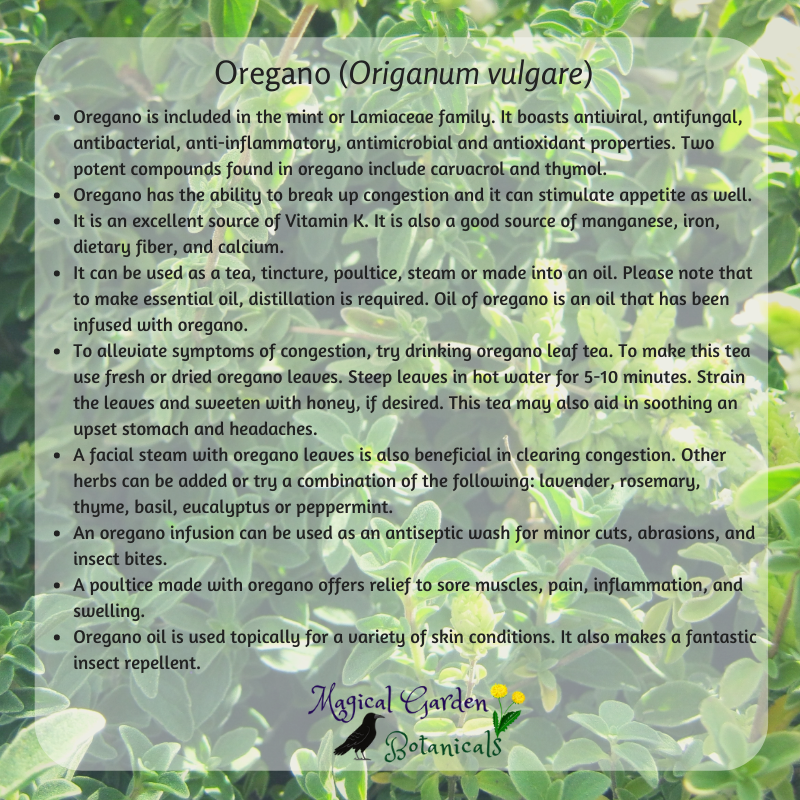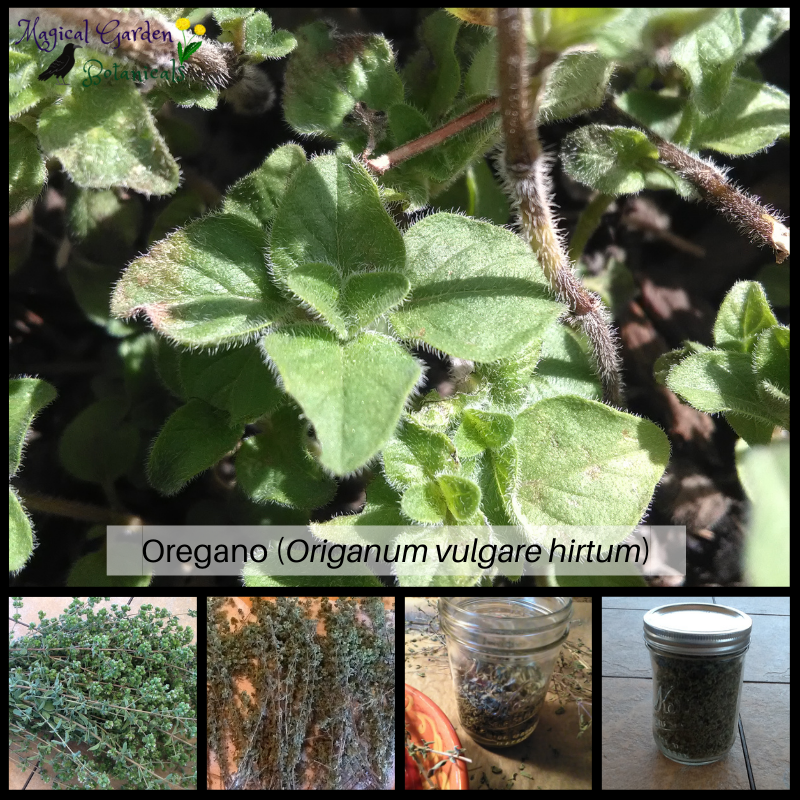Outstanding Oregano
Oregano (Origanum vulgare), is an herb commonly thought of when making recipes such as pizza sauce, pasta sauce, and other robust recipes. There are many varieties of oregano, including sweet marjoram. Common varieties are Greek and Italian oregano. However, the uses and benefits extend beyond culinary preparations.
A medicinal herb
Oregano is included in the mint or Lamiaceae family. It boasts antiviral, antifungal, antibacterial, anti-inflammatory, antimicrobial, and antioxidant properties. Two potent compounds found in oregano include carvacrol and thymol. Oregano has the ability to break up congestion and it can stimulate appetite as well. It is an excellent source of Vitamin K. It is also a good source of manganese, iron, dietary fiber, and calcium.
Although oregano is a natural substance, keep in mind that just like antibiotics, long-term use poses the possibility of developing resistant bacteria. The best recommendation here is to take breaks in between use or alternate with other antibacterial plants. Also, the antibacterial properties indicate that good and bad bacteria may be reduced or eliminated. Only use when necessary, as long as necessary. Afterward, be sure to replenish some of the much-needed beneficial bacteria with probiotic foods and supplements.
With these amazing properties, oregano offers a variety of medicinal applications. It can be used as a tea, tincture, poultice, steam, or made into an oil. Please note that to make essential oil, distillation is required. Oil of oregano is an oil that has been infused with oregano.
- To alleviate symptoms of congestion, try drinking oregano leaf tea. To make this tea use fresh or dried oregano leaves. Steep leaves in hot water for 5-10 minutes. Strain and sweeten with honey, if desired. This tea may also aid in soothing an upset stomach and headaches.
- A facial steam with oregano leaves is also beneficial in clearing congestion. Other herbs can be added or try a combination of the following: lavender, rosemary, thyme, basil, eucalyptus, or peppermint.
- An oregano infusion can be used as an antiseptic wash for minor cuts, abrasions, and insect bites.
- A poultice made with oregano offers relief to sore muscles, pain, inflammation, and swelling.
- Oregano oil is used topically for a variety of skin conditions. It also makes a fantastic insect repellent.
If you are pregnant or nursing, check with your health care provider prior to using oregano as a medicinal herb. In higher doses, oregano may interfere with the absorption of iron, zinc, and copper. Oregano may lower blood pressure and reduce high blood sugar levels. Please consult with your health care provider prior to use if you are undergoing treatment for these conditions. Avoid if known allergies are present and use caution if taking other medications. Please discuss with your own, qualified health care provider before making any dietary or lifestyle changes.

Harvesting oregano
As a general rule, it is best to harvest herbs in the early morning after the dew has dissipated and before the sun is too hot. This is the time of the day that the plant’s oil content is the highest. Also, for most plants, it’s optimal to harvest right before the plant goes into flower.
Recently, I harvested my oregano plants. I actually had two plants to harvest as I grow two varieties of oregano. The first variety is Italian Oregano (Origanum x majoricum) this is a cross of oregano and marjoram. The somewhat mild flavor makes it a great choice for culinary recipes. The second is Greek Oregano (Origanum vulgare hirtum), this variety offers an intense flavor. I use this one for cooking as well, although I primarily use it for medicinal applications.
Back to harvesting…
I stepped out into my garden to find the oregano was just about to flower. A harvest was confirmed after convening with the plants. With gratitude, I cut back the long sprigs and stalks. One plant would be used for cooking, the other for medicine. I washed the stalks and placed them on a drying rack. I allowed the stalks to dry for about 10 days. Since it was hot out, I just dried them on the countertop in my kitchen, away from direct sun. A dehydrator can also be used, however, make sure to dry on the lowest heat setting and remove promptly when fully dried. Another method, and also my preferred choice, is to tie them in bundles and hang them to dry in a dark, well-ventilated closet. Either way, be sure to dry them out of direct sunlight. Once dry, remove the leaves and store them in a tightly closed, clean jar. Alternatively, herbs can be stored on the stalks in a tightly sealed container. Store all herbs out of direct light and in a cool, dry place.
Happy harvesting!
Perhaps some of these suggestions will inspire you, dear reader, to look at oregano in another way. Maybe this will even encourage you to invite this outstanding healer into your home apothecary. I would love to hear how you are using oregano, leave a comment below.

This blog is for informational purposes only and is educational in nature. Statements made here have not been evaluated by the FDA. This blog is not intended to diagnose, treat, cure, or prevent any disease. Please discuss with your own, qualified health care provider before making any dietary or lifestyle changes.

Daughter of the Earth, Mother of her creations. Ivanna (Evie) doesn’t care for titles, but the ones that fit best are homeschool mom, herbalist, and blogger. Her greatest joy is guiding others to find true wellness within themselves and Mother Earth. When not spending time with her beloved family, she can be found researching everything related to holistic wellness, crafting herbal remedies, or visiting with the plants in the Magical Garden.





Response to "Outstanding Oregano"
Very informative ! Thank you
Thank you, Vivitha!